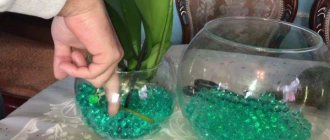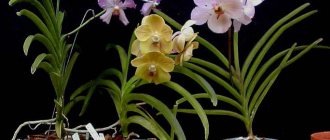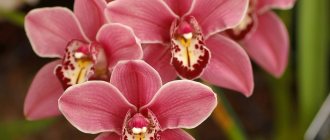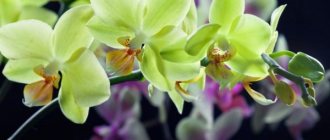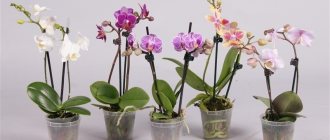Pros and cons of the method
Advantages of growing orchids using hydroponics:
- There is no need for constant replanting.
- The flower does not lack fertilizer.
- Since the appearance of soil pests and rot is a significant problem for orchids, this problem does not appear when grown in water.
- The root system receives all the necessary nutrients necessary for the favorable growth of the flower.
The problem of drying out roots and lack of oxygen disappears.- The time required to care for the plant is reduced, as there are automated solution circulation systems. You just need to add water at regular intervals. You can leave the phalaenopsis for a while and not worry about it drying out.
Disadvantages of using hydroponics:
- the water should be constantly cool;
- it is necessary to ensure that water covers the root system, and if necessary, top up;
- Feeding the orchid is carried out throughout its growth.
Methods of growing orchids
Orchids differ from most flowers not only in their unusually beautiful flowers. In the wild, they do not grow in the ground, but cling to the bark of trees. They receive moisture and nutrients through aerial roots. Water is taken from the air, rain and fog, nutrition is taken from the remains of useful substances accumulated in the bark of a tree. But all this happens in tropical conditions with high humidity, which is very difficult to provide in an apartment.
There are several ways to grow orchids:
- Soil use.
- The use of various inert substrates is called hydroculture.
- Growing in the air without soil or water is aeroponics.
- Hydroponics (in water).
If the roots of an orchid are constantly covered with water, they will not be able to breathe and will begin to be affected by fungus and rot. Therefore, they must be in a layer that is above the water. Although some gardeners keep water at the level of the roots exiting the base of the plant.
You need to gradually transfer the orchid to growing in water:
- Remove the flower from the soil, clean the roots from its remains and adhering particles of bark and foam. First, I immerse it in water for 2 days, then I let it dry for a day, draining it almost completely. The roots are immersed in water no more than a third of their length; when drained, 1 cm remains.
- After a week, increase the time in water to 5 days with one day of drying.
- Then they keep it constantly in water, changing it once a week and washing the pot and roots. When determining periods with and without water, they look at the condition of the roots. If they turn silver, the orchid needs to be watered.
During this time, young aerial roots will begin to actively grow, and development in the form of light green shoots will also be noticeable on the old ones. But sometimes with this method of growing, mold appears on the roots in the form of a white coating. To get rid of it, remove the plant from the water for a day, then treat the roots with a fungicide or hydrogen peroxide. Some gardeners advise not to remove algae that appears on the roots, because they help improve air exchange.
When the environment changes, some of the roots die off, and others are formed in their place, more adapted to growing in water.
To avoid mold damage, it is better to use semi-hydroculture, growing on a substrate. But this is not ordinary soil with a range of useful substances. The orchid does not receive nutrition from such a substrate. It simply holds her upright. The plant receives nutrients from special compounds that need to be added to the water. Fertilizers are in an easily digestible form, so the plant does not waste energy processing them and grows quickly.
Not all types of orchids are suitable for growing in water. Phalaenopsis and other domesticated species grow well in such conditions. Preference is given to those that do not have a rest period with drying of the roots:
- Phragmipedium.
- Dendrobium that prefers to grow in a cool room.
- Cattleya with flowers 20 cm in diameter. It grows better in warm climates and does not like heat.
- Mormodes, whose petals and sepals are often covered with spots, dots and streaks.
- Zygopetalum with fragrant bicolor and tricolor petals.
Step-by-step instructions for keeping it in solution
It is not necessary to use substrates and nutrient mixtures to provide the plant with adequate nutrition. All the necessary elements can be dissolved in water.
Composition and concentration of substances
It is necessary to add fertilizers to the water, the same as for soil cultivation. You need to feed the orchid constantly.
The concentration of fertilizers with this method should be equal to half the normal concentration when watering orchids in the ground.
Cleaning and inspection
Before planting, the roots are washed under running water and cleared of the previous substrate.
You can see green algae on the roots, but you shouldn't remove them. In the future, they will improve gas exchange in water when it stagnates.
Transplanting into a new pot
Depending on how many new roots the orchid has produced, you can determine whether it needs to be kept in the container further or whether it’s time to transplant it into a larger pot.
Before planting an orchid in expanded clay, its roots must be inspected and then washed under running water. The container is filled to half, the flower is transferred, after which water is added.- If it is decided to transfer the orchid to perlite, the container is filled with expanded clay. Then you should plant the orchid and sprinkle it with perlite, leaving one centimeter short of the edge of the container. The container is placed in water to compact the perlite around the roots. To decorate, you can sprinkle pebbles on top for decoration.
- When transferring a plant into diatomaceous earth, expanded clay is poured to the level of the covering hole, the orchid is transferred into diatomaceous earth and covered with expanded clay on top.
- If a greenmix mixture is used for planting, expanded clay is poured to the level of the covering hole, the orchid is transferred and the container is filled to the top with the mixture. To compact the resulting substrate, water it generously.
Important! The greenmix mixture and diatomaceous earth should not dry out. Otherwise, they will take moisture from the root system of the plant, and this will lead to the death of the flower.
How to grow a flower using this method?
In order for an orchid to bloom regularly, it is necessary not just water, but fertilized liquid. All added substances must have a calculated amount, then the flower will be fed evenly.
Keeping orchids without using soil is divided into the following types:
- Hydroponics – crops are grown in water.
- Hydroculture - substrate is added to water.
- Aeroponics - water is no longer used here, because the plant is grown in the air.
Reference! Since orchids in the wild do not grow in soil, but grow mainly on trees and rocks, the aquatic environment is their usual state.
Advantages and disadvantages
Hydroponic planting of orchids has significant advantages over soil growing:
No rot or soil parasites. This is very important for this culture. Since its root part is subject to rotting processes. With the hydroponics method, there is a large amount of air in the water; in addition, the rotting process is prevented by the constant circulation of liquid.- There is no need to regularly replant the flower.
- The plant does not suffer from too much or too little fertilizer.
- Regular enrichment of water with nutrients allows the flower to be strong and healthy. The roots do not suffer from drying out or lack of oxygen.
There are also some disadvantages of growing a flower in water, but on the other hand there are not as many of them as, for example, when growing plants in soil:
- It is necessary to ensure that the water is cool.
- It is worth making sure that the water level does not drop below the beginning of the root system. In this case, it is recommended to add liquid.
- Feeding is carried out during the entire growth of the orchid.
Thus, it is worth noting that caring for a flower in water should be regular.
Recommendations for home care
- When growing orchids in water, water quality plays an important role. It is better to pass it through a filter or use rainwater.
- Salt often accumulates in water containers. To eliminate it, the pots must be washed thoroughly with water every month.
- In winter, the water level in the container should not be higher than one centimeter.
- For feeding, it is better to use nutrient solutions taking into account the life phase of the orchid.
- In summer, the temperature should be cool in the room where the flower is located. In winter, the temperature should not exceed 25 degrees.
On our website there is a lot of information about orchids: about planting, Thai and Vietnamese orchids, growing from babies and in flasks, as well as in a closed system. Is it possible to use seeds to cultivate an orchid and how to grow a beautiful flower from seeds at home?
Care
If the window where the orchid is planted faces the south, then the plant needs to be darkened. In summer it is necessary to create a cool environment, and in winter the room temperature should not exceed 25 degrees.
The percentage of humidity in the room should be 25-35%, sometimes it is increased to 40-45%. This is especially important when new outlets appear. To do this, the pot is placed in a tray with water, and the substrate is sprayed with a spray bottle.
When new rosettes appear, watering should be plentiful. It is not recommended to spray the leaves of the plant, otherwise yellow spots will form on them. Fertilizer is also added when new rosettes appear through watering. It is recommended to add fertilizers no more than once every 2.5-3 weeks, otherwise an excess of nutrients will negatively affect the flower.
If you are new to floriculture, consult with professionals first. They will teach you how to properly water an orchid and care for it. After all, even fertilizing may depend on the type of plant and growth phase. And only then will this exotic flower regularly delight you with its blooms.
Growing in water is not the only option. Orchids can be grown in a flask or in a closed system. The reader will also be interested in articles about Thai orchids, planting and growing from bulbs, from children, from seeds purchased in China, and general information about seeds.
General provisions
Epiphytes - what are they and how do they grow in nature?
In nature, this exotic beauty grows on trees. But the flower is not a parasite, since it takes food for its development from the air and dead tree bark , which may be located in a crevice or other recess.
In this regard, the orchid belongs to the group of epiphytic plants growing on trees.
The structure of orchid roots
The roots of the plant consist of:
- Conductive thread;
- Parenchyma;
- Velamena;
- Apical tip of the root.
All parts are involved in photosynthesis of the plant and are vital for proper metabolism. With frequent watering, the velamen and parenchyma rot, exposing the root to a conductive thread. Therefore, drying of the flower is required.
Orchid root: 1 - Central cylinder; 2 - Epiblema; 3 - Velamen.
Basic rules of watering
When cultivating a plant, it is important to choose the right watering regime and water quality. Here are the basic rules for watering:
- Water the flower when the roots turn whitish or light gray. Green roots do not need watering;
- The bark should dry 2/3 of the container;
- The water used for irrigation should be warm, settled and soft. Water hardness can be reduced by boiling.
Sprinkling
You can bathe the plant in the shower - this is very useful . As a result, good leaves will grow and larger flowers will bloom.
Method of how to bathe an orchid using a shower to simulate rain:
- the plants are placed in the bathtub and watered with low pressure from the shower, but the water should be soft and warm 30-40 degrees ;
- imitate rain until the bark is completely wet, after which the flowers are left there so that the water completely drains from the substrate. There is no point in spraying water on the flowers ;
- after an hour, you need to wipe the sinuses of the leaf plates so that moisture does not accumulate there, which can lead to rotting of the leaf and its death. Especially the removal of moisture concerns such plant species as Phalaenopsis and Vanda.
Immersion method
Also very often, gardeners use immersion watering. This is used in most regions of Russia, because the water flowing from the tap is quite hard.
The main rules for how and how much to immerse orchids in water:
- water is prepared according to the parameters in advance;
- the container where the plant will be immersed must be of such a size that the immersed pot with a flower can wet its entire bark;
- immerse the container slowly so that the dry bark cannot push the roots of the flower into the air;
- The length of time plants should stand in water depends on the size of the root mass. Typically the dive lasts from 10 to 25 minutes ;
- After the watering procedure, you must allow the water to drain completely and only then place the container with the flower on the tray.
How to water a home orchid
The orchid family includes 28 thousand species growing in various conditions. Tropical orchids prefer substrates consisting of bark, while European orchids grow in the ground, like ordinary flowers. Their growing season and moisture requirements also vary greatly.
Therefore, it is very important for an orchid grower to know how to water an orchid of each specific type. After all, if tropical phalaenopsis requires a constantly moist substrate, then Mediterranean terrestrial orchids can withstand a six-month dry period.
What to look for when buying orchids
Be sure to choose a houseplant that is healthy, meaning without blemishes on the leaves and with firm, fleshy roots. Whitish spots and other plant pathologies are easy to see because many are sold in clear pots. Pay attention to the flower buds - they should not be dry, as this indicates a nutrient deficiency. An exotic plant may not bloom for a long time, even if there are buds. If you choose an orchid with developed flowers or with only one flower and buds that have not yet opened, then choose the latter option.
What kind of water do I use?
To keep orchids in water for a long time, gardeners advise using only filtered water at room temperature. Rainwater or water strained through peat will also work.
It’s not entirely correct to immediately place an orchid in tap water after purchasing it. There is a high probability that the roots will quickly rot. This is explained by the fact that strong chemicals are used to purify water in many cities, and the liquid itself is filled with heavy metals, losing nutrients that are so important for the orchid.
This method is used strictly for fixing and propagating roots. Today there is only one variety that tolerates tap water well - “Vanda”. Such orchids can also be grown in a glass vase.
Common diseases and pests of flowers
Fortunately, diseases and pests do not often affect demanding flowers. This usually happens if care tips are not followed or suitable conditions are not provided at home:
- Flabbiness of leaves. Occurs as a result of damage to the roots or a violation of the temperature regime.
- Cracks in the central part of the sheet. The consequences are not only mechanical damage, but also a sharp temperature change.
- The appearance of black spots, growths, bumps, holes on the leaves. Result of exposure to direct sunlight.
- Silvery web on the lower surface of the leaves. Spider mite infestation. These pests can only be eliminated with the help of special preparations.
- Drying and rotting of leaves. Consequences of the life activity of soft-bodied ticks. Most often they are located in the center of the sockets. To eliminate them, you will also have to use specialized chemicals.
- Slow growth, failure to flower. May be the result of the appearance of nematoids sucking the juice from the plant. They are removed with nematicides; you must act strictly according to the instructions.
Strict adherence to the recommendations allows you to count on regular and lush flowering of the selected orchid variety. Some varieties can bloom even in winter if they are properly approached and provided with a quality dormant period.
Possible problems and ways to solve them
Sometimes flower growers may encounter certain problems:
- The appearance of wrinkled edges of the flower. This is often caused by the room temperature being too high. Day and night temperatures should have a maximum difference of 8 degrees.
- Root rotting or drying. This problem can be caused by excessive watering or too narrow a pot, which negatively affects the root system of the plant.
- Lack of flowering. In this case, you can try to arrange temperature stress for the plant, that is, make it so that the day and night temperatures differ, but not by more than 8 degrees.
Reanimation of an orchid in water
The hydroponics method can also be used to save a plant that has lost its roots. This happens for various reasons: from overwatering and rotting, as a result of infection, pests, etc. It is a pity to throw away the affected plant. After all, you can try to save him.
You can grow roots using water and a special rooting method:
- clean the roots from rot and dried particles using a disinfected knife;
- treat the neck with a fungicide, sprinkle the cut areas with activated carbon;
- dry the plant well overnight so that all wounds heal;
- pour settled water into the jar, place the flower on top with the neck down so that there is a distance of 1-2 cm to the surface (do not touch the water with the rosette);
- put the jar with the orchid in a warm place, and the water must be changed every week;
- Wipe the leaves daily with a solution of succinic acid, because from lack of moisture they will become lethargic and wrinkled;
- After a month of careful care, the first roots and even fresh leaves may appear, which depends on the condition of the flower.
Such resuscitation of an orchid without roots in water will help save the damaged plant, giving it a new life.
About the substrate
As already noted, hydroculture is the use of a substrate, and hydroponics is only water. Many gardeners prefer the first option, considering it aesthetically more attractive. How much substrate is needed depends on its type.
How to fill the substrate:
- diatomaceous earth should be alternated with expanded clay, filling it up to the beginning of the holes;
- expanded clay as a monocomposition should be filled to the middle, then a flower is placed, and the substrate is added again;
- if you decide to use perlite, then the bottom is first covered with an expanded clay layer, then the flower is placed, and perlite is added to a distance of 1 cm from the holes;
- The greenmix is filled up, watered up to the drainage holes, after which the plant mixture is poured.
An orchid in a pot with a substrate should stand confidently.
By choosing a bulk product, you can interestingly play up the image of a flower: enhance its tenderness or play with contrast.
The basic rule is constant monitoring of water levels. But other advice should not be ignored either.
Rules of care:
- the temperature in the room in winter cannot be below 25 degrees;
- to create flower buds, you need to organize a preparatory period of two weeks, during which time the temperature should be below 15 degrees;
- good air humidity - no more than 75%, it is fundamentally important to observe this criterion during the period of growth of rosettes, which is helped by growing in water, because evaporated moisture increases air humidity;
- a flowerpot with a flower is placed away from drafts, in summer - on the balcony so that direct rays of the sun do not injure it;
- rainwater is used for topping up; alternatively, water filtered through charcoal (this is important for softness);
- the leaves of the orchid should not touch the water - this precedes rotting, and if drops fall on the leaves during watering, they are removed with a soft cloth or napkin;
- from time to time inspect and clean the holes in the flowerpots;
- replace the solution every 3 days;
- Rinse the pot monthly, the roots need to be wiped and dried for 6 minutes, then immersed in the solution again.
The container for growing is preferably transparent. Glass vases may seem like an attractive option, but they won't be useful. Still, this material is cold, and it is almost impossible to make normal holes in it. Therefore, flower growers choose plastic flowerpots, which are sold in flower shops everywhere.
There must be holes for air exchange in the flowerpot.

